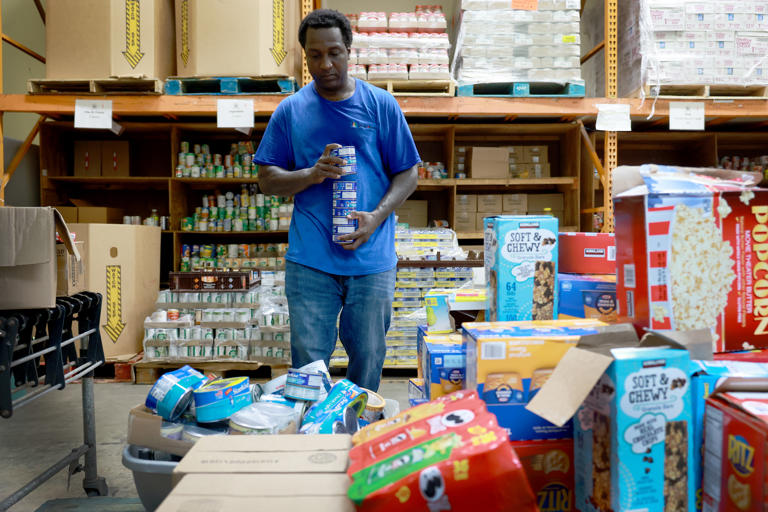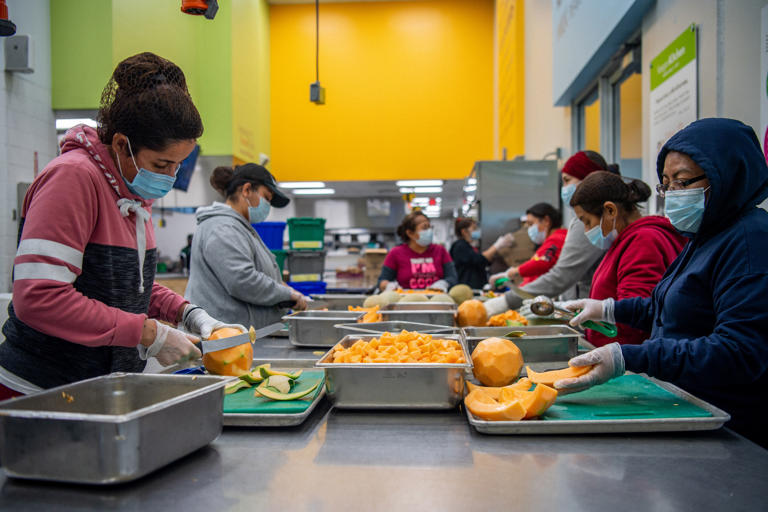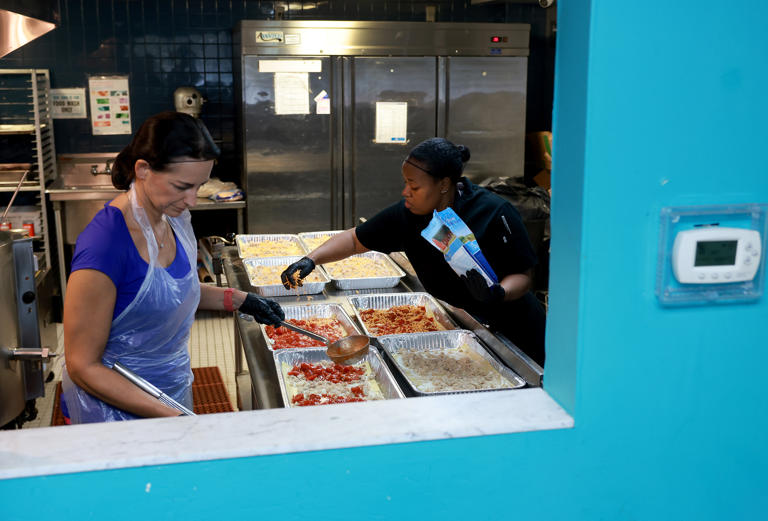© Joe Raedle/Getty Images
Moving beyond efforts to block expansion of health care for the poor and disabled, Republican governors in 15 states are now rejecting a new, federally funded summer program to give food assistance to hungry children.
The program is expected to serve 21 million youngsters starting around June, providing $2.5 billion in relief across the country.
The governors have given varying reasons for refusing to take part, from the price tag to the fact that the final details of the plan have yet to be worked out. Iowa Gov. Kim Reynolds (R) said she saw no need to add money to a program that helps food-insecure youths “when childhood obesity has become an epidemic.” Nebraska Gov. Jim Pillen (R) said bluntly, “I don’t believe in welfare.”
Republican leaders have been criticized for playing politics with children in need, but they argue it is necessary to revert to pre-pandemic spending levels at a time when the United States is trillions of dollars in debt and lawmakers in Washington are struggling to come to a budget agreement. The summer food program was approved as part of a bipartisan budget agreement in 2022.
“It’s sad,” Agriculture Secretary Tom Vilsack said, noting that the program has support from other states run by Republicans and Democrats. “There isn’t really a political reason for not doing this. This is unfortunate. I think governors may not have taken the time or made the effort to understand what this program is and what it isn’t.”
The U.S. Agriculture Department said Wednesday that 35 states, U.S. territories and Native American tribes indicated by the Jan. 1 deadline that they would be participating in the summer food assistance program. It will provide families with incomes below the poverty level who already get school lunches for a reduced price or free with $120 per child to buy food at grocery stores, farmers markets or other approved retailers. The USDA called it “a giant step forward” in meeting the needs of the country’s families in the summer months, when food assistance in schools is not available.
Those who work with families in states where the food money has been turned down said the impact will be devastating and add pressure to private food banks. Hunger in the United States is on the rise as pandemic aid programs have wound down and food costs have skyrocketed. In 2022, food insecurity rates increased sharply, with 17.3 percent of households with children lacking enough food, up from 12.5 percent in 2021, according to the USDA.
In Oklahoma, for example, pandemic food relief money has been helping more than 350,000 children in need for the past four summers. Now that money has dried up with no statewide replacement on the way, and nonprofit assistance groups are scrambling to fill the gap.
“It’s just heartbreaking,” said Stacy Dykstra, chief executive of the Regional Food Bank of Oklahoma, noting that 3 in 5 school-age children in her state who qualify for free or reduced-cost lunches at school would be eligible for the new program. “Many children this summer won’t have access to the food they need. It is really scary and gives me goose bumps just saying it out loud to you.”

Washington Louis sorts through cans of food for those in need at the LifeNet4Families community food pantry in Fort Lauderdale, Fla.© Joe Raedle/Getty Images
Other states declining to participate are Alabama, Alaska, Florida, Georgia, Idaho, Louisiana, Mississippi, South Carolina, South Dakota, Texas, Vermont and Wyoming. Four of these states — Florida, Georgia, South Carolina and Wyoming — are among the seven that have not fully extended Medicaid eligibility to low-income individuals.
The push for a summer benefit program dates back more than a decade, according to Katie Bergh, a senior policy analyst at the Center on Budget and Policy Priorities, a Washington-based nonpartisan research and policy institute. Studies of early pilot programs showed that summer grocery assistance helped decrease the percentage of children suffering from the most extreme hunger by one-third and also expanded access to healthier, more expensive options like fruits, vegetables and whole grains.
That is why many nutrition advocates were dismayed by Reynolds’s contention in a statement last week that Iowa was opting out of the summer program because it has “few restrictions on food purchases” and “does nothing to promote nutrition at a time when childhood obesity has become an epidemic.”
“There is no evidence that a program like this has anything to do with childhood obesity,” said Erica Kenney, an assistant professor at Harvard University’s T.H. Chan School of Public Health who studies childhood nutrition programs and their effects. “It’s absolutely true you can have obesity and be struggling to get food on the table for your family. It is not at all true that helping people who are struggling financially means they’re going to eat more and gain weight.”
Reynolds noted that the state served 1.6 million meals to Iowa’s children last summer at 500 meal sites and said it would be expanding “already existing childhood nutrition programs.”
Nutrition advocates have long pushed for food assistance programs for the summer months that go beyond existing on-site meal programs that can be hard for parents to access, especially in rural areas. Only about 1 in 6 children eligible for summer feeding sites actually make it there because of transportation difficulties, according to the USDA.


Volunteers cut and prepare fruit at a Houston Food Bank facility on Feb. 8, 2022.© Brandon Bell/Getty Images
In Oklahoma, Gov. Kevin Stitt (R) has given varying reasons for not joining the program, including that there was not yet enough information, that it was “duplicative” of existing federal programs and that he was “satisfied” with the state’s current resources.
“Governor Stitt was not comfortable opting into a program where the rules weren’t finalized,” Stitt’s spokeswoman, Abegail Cave, said in an email. “He has not shut the door on participating in future years. The Oklahoma Department of Human Services and the Oklahoma State Department of Education as well as multiple nonprofits go to great efforts every summer to ensure that kids in Oklahoma don’t go hungry.”
Chris Bernard, the chief executive of Hunger Free Oklahoma, said that with the state not opting into the program, an estimated 300,000 children won’t have access to the summer monetary benefit when school lets out. Three of the state’s sovereign Indian nations — the Cherokee, Chickasaw and Osage — have decided to join the new program, expecting to reach about 100,000 students, Bernard said.
Roxey Clayburn, 33, a stay-at-home mother from Oklahoma City, said that having no replacement for the money her family received in pandemic assistance in previous summers will mean she and her husband, a plumber, will have to skimp on fruit and other snacks for her daughters, ages 9 and 10, when school lets out.
“It’s stressful,” Clayburn said, “because they’re here all day in the summertime, and the bigger they get, the more they eat, too.” She said she is going to try to plant a garden so the family will have access to vegetables.
Vilsack said the USDA is still talking to some states about the possibility of joining the program, either this year or in 2025.
And in Nebraska, a bipartisan group of state senators is filing legislation to force the state’s Department of Health and Human Services to opt in, according to state Sen. Jen Day (D) from Omaha.
Pillen, the Nebraska governor, said in a statement that the program is “unnecessary and is not adequate to meeting the needs of children. … Handing out money is not enough to meet kid’s needs. They need much more.”
Moving beyond efforts to block expansion of health care for the poor and disabled, Republican governors in 15 states are now rejecting a new, federally funded summer program to give food assistance to hungry children.
The program is expected to serve 21 million youngsters starting around June, providing $2.5 billion in relief across the country.
The governors have given varying reasons for refusing to take part, from the price tag to the fact that the final details of the plan have yet to be worked out. Iowa Gov. Kim Reynolds (R) said she saw no need to add money to a program that helps food-insecure youths “when childhood obesity has become an epidemic.” Nebraska Gov. Jim Pillen (R) said bluntly, “I don’t believe in welfare.”
Republican leaders have been criticized for playing politics with children in need, but they argue it is necessary to revert to pre-pandemic spending levels at a time when the United States is trillions of dollars in debt and lawmakers in Washington are struggling to come to a budget agreement. The summer food program was approved as part of a bipartisan budget agreement in 2022.
“It’s sad,” Agriculture Secretary Tom Vilsack said, noting that the program has support from other states run by Republicans and Democrats. “There isn’t really a political reason for not doing this. This is unfortunate. I think governors may not have taken the time or made the effort to understand what this program is and what it isn’t.”
The U.S. Agriculture Department said Wednesday that 35 states, U.S. territories and Native American tribes indicated by the Jan. 1 deadline that they would be participating in the summer food assistance program. It will provide families with incomes below the poverty level who already get school lunches for a reduced price or free with $120 per child to buy food at grocery stores, farmers markets or other approved retailers. The USDA called it “a giant step forward” in meeting the needs of the country’s families in the summer months, when food assistance in schools is not available.
Those who work with families in states where the food money has been turned down said the impact will be devastating and add pressure to private food banks. Hunger in the United States is on the rise as pandemic aid programs have wound down and food costs have skyrocketed. In 2022, food insecurity rates increased sharply, with 17.3 percent of households with children lacking enough food, up from 12.5 percent in 2021, according to the USDA.
In Oklahoma, for example, pandemic food relief money has been helping more than 350,000 children in need for the past four summers. Now that money has dried up with no statewide replacement on the way, and nonprofit assistance groups are scrambling to fill the gap.
“It’s just heartbreaking,” said Stacy Dykstra, chief executive of the Regional Food Bank of Oklahoma, noting that 3 in 5 school-age children in her state who qualify for free or reduced-cost lunches at school would be eligible for the new program. “Many children this summer won’t have access to the food they need. It is really scary and gives me goose bumps just saying it out loud to you.”

Washington Louis sorts through cans of food for those in need at the LifeNet4Families community food pantry in Fort Lauderdale, Fla.© Joe Raedle/Getty Images
Other states declining to participate are Alabama, Alaska, Florida, Georgia, Idaho, Louisiana, Mississippi, South Carolina, South Dakota, Texas, Vermont and Wyoming. Four of these states — Florida, Georgia, South Carolina and Wyoming — are among the seven that have not fully extended Medicaid eligibility to low-income individuals.
The push for a summer benefit program dates back more than a decade, according to Katie Bergh, a senior policy analyst at the Center on Budget and Policy Priorities, a Washington-based nonpartisan research and policy institute. Studies of early pilot programs showed that summer grocery assistance helped decrease the percentage of children suffering from the most extreme hunger by one-third and also expanded access to healthier, more expensive options like fruits, vegetables and whole grains.
That is why many nutrition advocates were dismayed by Reynolds’s contention in a statement last week that Iowa was opting out of the summer program because it has “few restrictions on food purchases” and “does nothing to promote nutrition at a time when childhood obesity has become an epidemic.”
“There is no evidence that a program like this has anything to do with childhood obesity,” said Erica Kenney, an assistant professor at Harvard University’s T.H. Chan School of Public Health who studies childhood nutrition programs and their effects. “It’s absolutely true you can have obesity and be struggling to get food on the table for your family. It is not at all true that helping people who are struggling financially means they’re going to eat more and gain weight.”
Reynolds noted that the state served 1.6 million meals to Iowa’s children last summer at 500 meal sites and said it would be expanding “already existing childhood nutrition programs.”
Nutrition advocates have long pushed for food assistance programs for the summer months that go beyond existing on-site meal programs that can be hard for parents to access, especially in rural areas. Only about 1 in 6 children eligible for summer feeding sites actually make it there because of transportation difficulties, according to the USDA.

Volunteers cut and prepare fruit at a Houston Food Bank facility on Feb. 8, 2022.© Brandon Bell/Getty Images
In Oklahoma, Gov. Kevin Stitt (R) has given varying reasons for not joining the program, including that there was not yet enough information, that it was “duplicative” of existing federal programs and that he was “satisfied” with the state’s current resources.
“Governor Stitt was not comfortable opting into a program where the rules weren’t finalized,” Stitt’s spokeswoman, Abegail Cave, said in an email. “He has not shut the door on participating in future years. The Oklahoma Department of Human Services and the Oklahoma State Department of Education as well as multiple nonprofits go to great efforts every summer to ensure that kids in Oklahoma don’t go hungry.”
Chris Bernard, the chief executive of Hunger Free Oklahoma, said that with the state not opting into the program, an estimated 300,000 children won’t have access to the summer monetary benefit when school lets out. Three of the state’s sovereign Indian nations — the Cherokee, Chickasaw and Osage — have decided to join the new program, expecting to reach about 100,000 students, Bernard said.
Roxey Clayburn, 33, a stay-at-home mother from Oklahoma City, said that having no replacement for the money her family received in pandemic assistance in previous summers will mean she and her husband, a plumber, will have to skimp on fruit and other snacks for her daughters, ages 9 and 10, when school lets out.
“It’s stressful,” Clayburn said, “because they’re here all day in the summertime, and the bigger they get, the more they eat, too.” She said she is going to try to plant a garden so the family will have access to vegetables.
Vilsack said the USDA is still talking to some states about the possibility of joining the program, either this year or in 2025.
And in Nebraska, a bipartisan group of state senators is filing legislation to force the state’s Department of Health and Human Services to opt in, according to state Sen. Jen Day (D) from Omaha.
Pillen, the Nebraska governor, said in a statement that the program is “unnecessary and is not adequate to meeting the needs of children. … Handing out money is not enough to meet kid’s needs. They need much more.”

No comments:
Post a Comment